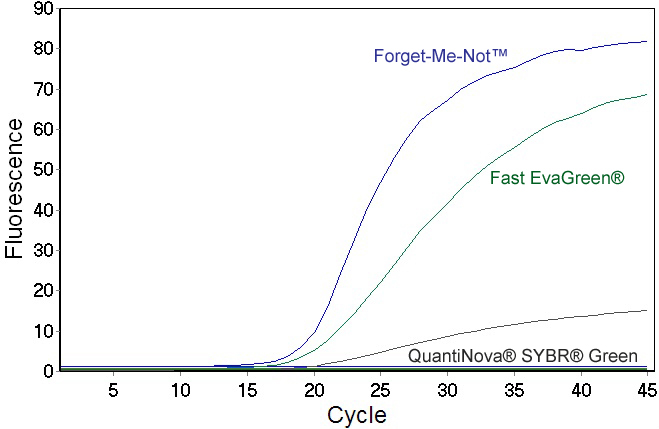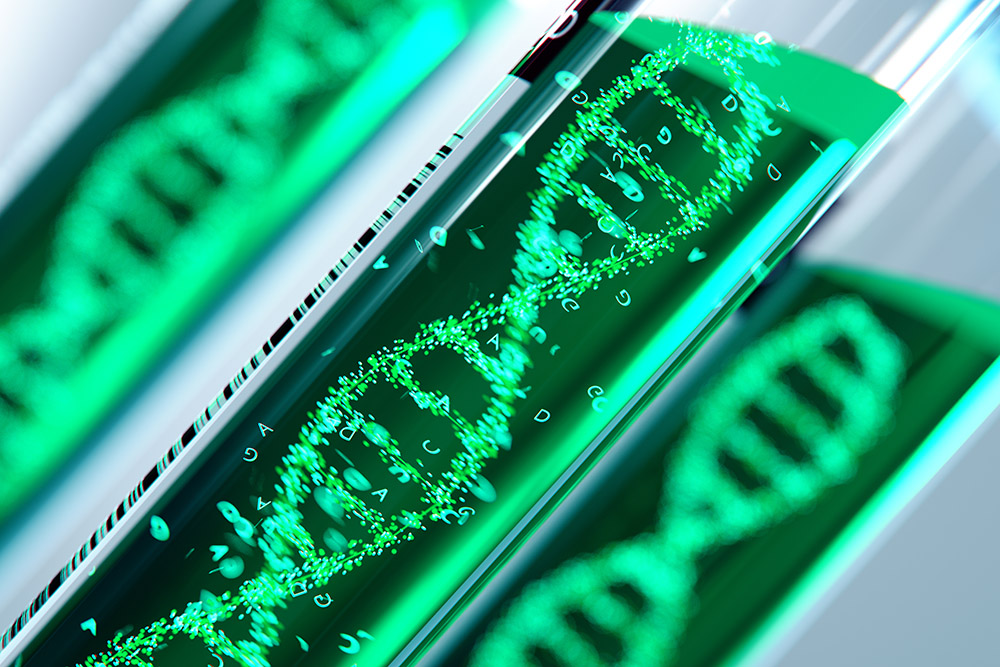The development of the polymerase chain reaction (PCR) in 1983 by Kary Mullis and coworkers revolutionized molecular biology, allowing scientists to amplify DNA sequences for various applications.1 Roughly a decade later, research by Higuchi et al. led to the discovery that PCR amplification can be monitored in real time using fluorogenic nucleic acid probes, allowing for quantitative real-time PCR (qPCR).2 This technique now underpins applications like measuring levels of gene expression, rapid forms of paternity testing, scanning for mutations in target genes, and the diagnosis of many infectious diseases.
Initially, ethidium bromide (EtBr) was commonly used as a DNA-binding fluorescent dye for monitoring qPCR. Its drawbacks, including being a potential human mutagen, led to the introduction of SYBR® Green I. SYBR® Green I has brighter fluorescent signal than EtBr, but researchers soon realized that it was also a mutagen. This, along with SYBR® Green I’s propensity for background fluorescence, its inhibitory properties, and its lack of stability following multiple freeze-thaw cycles and under PCR conditions inspired Biotium scientists to develop EvaGreen® and EvaGreen® Plus Dye for qPCR. These dyes have now been helping scientists optimize their PCR, qPCR, LAMP, HRM, and ddPCR (droplet digital PCR) data for over 15 years.

EvaGreen® Dye uses a novel concept of DNA binding via a “release-on-demand” mechanism, which means the dye is essentially non-fluorescent by itself but becomes highly fluorescent upon binding to dsDNA (Fig. 1). The dye is constructed of two monomeric dyes linked by a flexible spacer. In the absence of DNA, the dimeric dye assumes a looped conformation that is non-fluorescent in the absence of DNA. When DNA is available, the looped conformation shifts via an equilibrium to an active form that is capable of binding to DNA and emitting fluorescence. This unique property of EvaGreen® suppresses background fluorescence of unbound dye, allowing for significantly better signal-to-noise when compared to other qPCR dyes. In this article, we’ll explore a few techniques that grew from Mullis’ and Higuchi’s groundbreaking discoveries and consider some of EvaGreen® Dye’s key advantages in these applications.
Enhancing PCR and qPCR Performance
The unique properties of EvaGreen® Dye have made it particularly useful in qPCR. Compared to SYBR® Green I, it is generally less inhibitory toward PCR and less likely to cause non-specific amplification thanks to the dye’s stronger preferential binding to dsDNA over ssDNA12. Therefore, EvaGreen® Dye can be used at a much higher dye concentration than SYBR® Green I, resulting in more robust PCR signal (Fig. 2). EvaGreen® is also compatible with multiplex PCR, as the lack of dye migration from amplicon to amplicon enables the detection of multiple PCR products by melt curves. This is thanks to EvaGreen® Dye’s higher affinity for DNA as a dimer.

Unveiling the Full Potential of LAMP
Loop-mediated isothermal amplification’s (LAMP) simplicity and speed make the method particularly attractive for point-of-care diagnostics in resource-limited contexts. It also shines in field settings where it’s used for rapid detection of plant pathogens or infectious disease agents like malaria, tuberculosis, and SARS-CoV-2.10, 11 Both LAMP and PCR amplify DNA, but there are a few key differences:
- Temperature: The strand-displacing properties of Bst DNA polymerase used in LAMP allows for rapid amplification of a specific sequence at one temperature (60-65° C). Standard PCR requires cycling between multiple temperatures to denature the DNA, anneal primers, and extend the new strand.
- Generated product: PCR generates many copies of discrete, single-sized amplicons while LAMP creates long concatemers of the same repeated sequence.
- Reaction duration: PCR thermocycling protocols often take at least 1.5 hours, while LAMP reactions are complete in 30-40 minutes.
Because of SYBR® Green I’s inhibitory effect on DNA polymerization at higher concentrations, it’s mainly used as an end point reporter in LAMP.4 As summarized by Fishbach et al., EvaGreen® is more suited for real-time monitoring of LAMP reactions as it does not impact DNA polymerization and, therefore, can be present throughout the entirety of the reaction.4, 7, 8
Increasing Precision in High-Resolution Melting (HRM®) Experiments
HRM® is a post-PCR method for analyzing the melt curves of amplified DNA fragments. The method requires a DNA binding dye like EvaGreen®, and an instrument with exceptional thermal sensitivity that can distinguish melt curves between fragments with small sequence variations. The analysis can be used for DNA mapping, mutation scanning, species identification, zygosity testing, DNA fingerprinting, and more.
Despite its popularity, SYBR® Green I has been found to be unreliable for HRM® due to problems caused by dye redistribution at higher concentrations. EvaGreen® was designed to be less inhibitory in the PCR reactions, permitting the use of saturating dye concentration for maximal signal and better high-resolution DNA melt analysis with less dye redistribution. 5,6
The only DNA dye suitable for multiplex ddPCR
Droplet digital PCR (ddPCR) is a digital PCR method that is based on water-oil emulsion droplet technology. The sample is fractionated into tens of thousands of droplets, which act as individual test tubes or wells in a plate in which the PCR reaction takes place. The technique allows researchers to multiplex targets from the same sample and requires smaller sample amounts than other commercially available digital PCR systems. This results in lower sample and reagent volume requirements and reduced overall cost while maintaining the sensitivity and precision of digital PCR. Digital PCR techniques, like ddPCR, also offer the ability for absolute quantification of molecules.
TaqMan® probes have traditionally been used for this technique, but their expense and the required complexity in assay design are significant drawbacks. EvaGreen® is less likely to inhibit PCR and promote mispriming than competitor DNA-binding dyes, and it shows superior performance when used in qPCR and for high resolution melt curve analysis. This makes it a promising tool for ddPCR. McDermott et al. confirmed its effectiveness in their 2013 paper in which they identified EvaGreen® as the only DNA-binding dye validated for ddPCR in their experimental system. In this study, they also found that EvaGreen® increased resolution and allowed for the quantification of multiple target species in a single well of droplets.9
A Breakthrough in Safety
DNA-binding dyes are inherently dangerous due to their potential to cause mutations. Ohta et al. found SYBR® Green I to be even more environmentally toxic than ethidium bromide, a well-known mutagen.13 No safety data currently exists on other common PCR and HRM dyes (e.g., SYTO®9, LCGreen®, BRYT Green®, and ResoLight). However, these dyes are known for quickly permeating cells and posing a potential risk of genotoxicity. This motivated Biotium scientists to create EvaGreen®, a dye that is impenetrable to latex gloves and cell membranes, with metabolites that have little or no interaction with DNA. Testing by Biotium and independent testing services confirmed that it is noncytotoxic and nonmutagenic at concentrations well above the working concentrations used in qPCR.
References
- Saiki, R. K., Scharf, S., Faloona, F., Mullis, K. B., Horn, G. T., Erlich, H. A., & Arnheim, N. (1985). Enzymatic amplification of beta-globin genomic sequences and restriction site analysis for diagnosis of sickle cell anemia. Science (New York, N.Y.), 230(4732), 1350–1354. https://doi.org/10.1126/science.2999980
- Higuchi, R., Fockler, C., Dollinger, G., & Watson, R. (1993). Kinetic PCR analysis: real-time monitoring of DNA amplification reactions. Bio/technology (Nature Publishing Company), 11(9), 1026–1030. https://doi.org/10.1038/nbt0993-1026
- Ishino, S., & Ishino, Y. (2014). DNA polymerases as useful reagents for biotechnology – the history of developmental research in the field. Frontiers in microbiology, 5, 465. https://doi.org/10.3389/fmicb.2014.00465
- Fischbach, J., Xander, N. C., Frohme, M., & Glökler, J. F. (2015). Shining a light on LAMP assays–a comparison of LAMP visualization methods including the novel use of berberine. BioTechniques, 58(4), 189–194. https://doi.org/10.2144/000114275
- Wittwer, C. T., Reed, G. H., Gundry, C. N., Vandersteen, J. G., & Pryor, R. J. (2003). High-resolution genotyping by amplicon melting analysis using LCGreen. Clinical chemistry, 49(6 Pt 1), 853–860. https://doi.org/10.1373/49.6.853
- Giglio, S., Monis, P. T., & Saint, C. P. (2003). Demonstration of preferential binding of SYBR Green I to specific DNA fragments in real-time multiplex PCR. Nucleic acids research, 31(22), e136. https://doi.org/10.1093/nar/gng135
- Mair, G., Vilei, E.M., Wade, A. et al.Isothermal loop-mediated amplification (lamp) for diagnosis of contagious bovine pleuro-pneumonia. BMC Vet Res 9, 108 (2013). https://doi.org/10.1186/1746-6148-9-108
- Tomlinson, J. A., Barker, I., & Boonham, N. (2007). Faster, simpler, more-specific methods for improved molecular detection of Phytophthora ramorum in the field. Applied and environmental microbiology, 73(12), 4040–4047. https://doi.org/10.1128/AEM.00161-07
- McDermott, G. P., Do, D., Litterst, C. M., Maar, D., Hindson, C. M., Steenblock, E. R., Legler, T. C., Jouvenot, Y., Marrs, S. H., Bemis, A., Shah, P., Wong, J., Wang, S., Sally, D., Javier, L., Dinio, T., Han, C., Brackbill, T. P., Hodges, S. P., Ling, Y., … Lowe, A. J. (2013). Multiplexed target detection using DNA-binding dye chemistry in droplet digital PCR. Analytical chemistry, 85(23), 11619–11627. https://doi.org/10.1021/ac403061n
- González-González, E., Trujillo-de Santiago, G., Lara-Mayorga, I. M., Martínez-Chapa, S. O., & Alvarez, M. M. (2020). Portable and accurate diagnostics for COVID-19: Combined use of the miniPCR thermocycler and a well-plate reader for SARS-CoV-2 virus detection. PloS one, 15(8), e0237418. https://doi.org/10.1371/journal.pone.0237418
- El-Tholoth, M., Bau, H. H., & Song, J. (2020). A Single and Two-Stage, Closed-Tube, Molecular Test for the 2019 Novel Coronavirus (COVID-19) at Home, Clinic, and Points of Entry. ChemRxiv: the preprint server for chemistry, 10.26434/chemrxiv.11860137.v1. https://doi.org/10.26434/chemrxiv.11860137.v1
- Mao, F., Leung, W. Y., & Xin, X. (2007). Characterization of EvaGreen and the implication of its physicochemical properties for qPCR applications. BMC biotechnology, 7, 76. https://doi.org/10.1186/1472-6750-7-76
- Ohta, T., Tokishita, S., & Yamagata, H. (2001). Ethidium bromide and SYBR Green I enhance the genotoxicity of UV-irradiation and chemical mutagens in E. coli. Mutation research, 492(1-2), 91–97. https://doi.org/10.1016/s1383-5718(01)00155-3
SYBR and SYTO are registered trademarks of Thermo Fisher Scientific; LCGreen is a registered trademark of Biofire; BRYT Green is a registered trademark of Promega; HRM is a registered trademark of Idaho Technologies; QuantiNova is a registered trademark of Qiagen.






